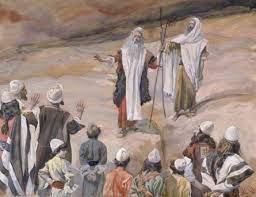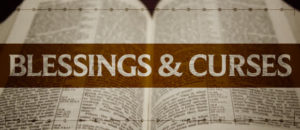This month we start a new series looking at the blessings and curses in these chapters and what we can learn from them today.
When you walk into my study you will notice a number of things like a computer and a great many books. But over in the corner is one of the most important things in the room, and that is my notice board. It has various bits of paper on it. These are things I need to be reminded of, so they get dealt with. What we are dealing with at the start of this chapter is  similar, as it is how the Israelites were to remind themselves of the Law that the Lord had given them and as importantly, how they were to obey that Law.
similar, as it is how the Israelites were to remind themselves of the Law that the Lord had given them and as importantly, how they were to obey that Law.
At the end of chapter 26 there was, metaphorically, the signing of the covenant between the Lord and the people of Israel. But the emphasis here is not just on the keeping of these commands, but also the consequences of not keeping them.
In chapter 27 Moses is mentioned in the third person which has not been the case since 5:1 as chapters 5-26 are presented as Moses’ speeches to Israel. So, let me put forward what I think is happening here. My wife and I enjoy watching movies, but I am also very interested in the composition of movies, the how and whys of how films are put together. So this is bit like the director of a movie getting the camera to draw back to give us a new perspective. Whereas close-ups focus our attention on one thing, when the camera draws back to a wide short we can see much more. The emphasis of the text has been on Moses teaching the Law, but now the people are being reminded that this Law has consequences which could be good or bad depending on how they react to it. Hence, what we are getting here is, in movie terms, is a wide shot, as we are now not just thinking just about what Moses is teaching, but also about the consequences of the Law.
The chapter starts with a command which is issued by Moses and the elders, and this is that the people are to be faithful in keeping the Law, not just at the present time, but when they cross the Jordan and reach the Land. So, when they do this they were to: ‘set up large stones and plaster them with plaster.’ On the stones they are to write: ‘all the words of this law’ (v3). Within this command there is a reminder that the land is part of God’s blessing and promise to His people, as seen in the phase: ‘a land flowing with milk and honey, as the Lord, the God of your fathers, has promised you’ (v3). There is an emphasis on God’s faithfulness despite the disobedience that the Israelites had shown during the Exodus.  Therefore, the gist of these first few verses is that they are to continue in faithfully keeping the Law when they enter the Land.
Therefore, the gist of these first few verses is that they are to continue in faithfully keeping the Law when they enter the Land.
But how would they be sure that they were continuing to be faithful? This is where the stones came in. Just as my notice board acts as a reminder to me, these stones would act as a reminder to the Israelites as all the words of the Law were to be written on them: ‘very plainly’ (v8). What this quite means is not certain. Was the Law written out in its entirety (after all these were large stones), or just the Ten Commandments as an effective summary? But whether it was the whole or part of the Law these stones would have acted as an effective reminder.[1] The place that these stones were to be set up was to be Mount Ebal (which is first mentioned in Deuteronomy in chapter 11). Mount Ebal had an interesting history as it is a place where Abraham first sacrificed in the Land (Genesis 12:6-7). Later Jacob built an alter there (Genesis 33:18-20) and perhaps this is why it was chosen as it emphasises the Lord’s faithfulness to His people. By the stones was an alter that was to be built out of uncut stones (Exodus 20:25) distinguishing it from the Canaanite alters where the stones would have been fashioned with the tools of the time. As Paul Brown points out: ‘the associations of such implements were all pagan.’[2]
Once the alter was completed there were to be sacrifices of: ‘burnt offerings’ ‘which symbolise the entire consecration of the offering to God’[3] and also: ‘peace offerings’ , these representing fellowship between the people of God (vs6-7). What is notable here is that once they were in the Land and had completed this command there was to be rejoicing that God had brought them into the Land and had given them this Law. This reminds us that when we come together our worship should be joyful as we study God’s Word and goodness towards us!
[1] If the idea seems a bit quaint and removed from the present day, we should remember that many churches have the Ten Commandments situated in a prominent place. Indeed, in the Anglican Church it is part of church law that they should be displayed.
[2] Paul E. Brown, Deuteronomy, An Expositional Commentary.(Day one, Leominster, 2008), 197.
[3] Allan Harman. Deuteronomy, the Commands of the Covenant God (Christian focus publications, Fearn, 2001) 231.